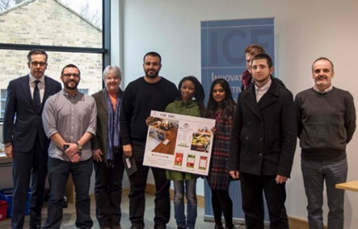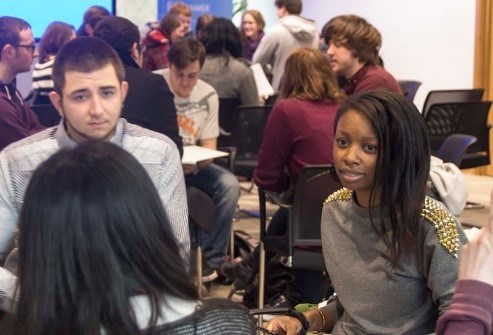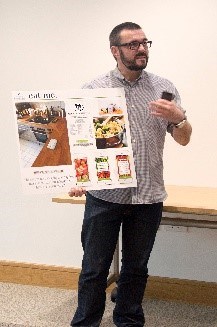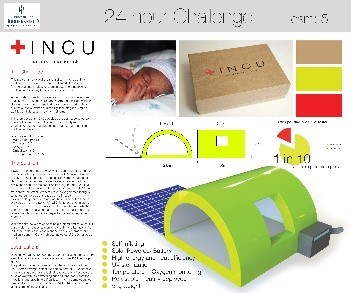Group Size
?
1.) Small group (teams of 4-6)
2.) Individual Task
3.) Large Group
4.) Any
Small group (teams of 4-6), Large Group
Learning Environment
?
1.) Lecture Theatre
2.) Presentation Space
3.) Carousel Tables (small working group)
4.) Any
5.) Outside
6.) Special
Carousel Tables (small working group)
QAA Enterprise Theme(s)
?
1.) Creativity and Innovation
2.) Opportunity recognition, creation and evaluation
3.) Decision making supported by critical analysis and judgement
4.) Implementation of ideas through leadership and management
5.) Reflection and Action
6.) Interpersonal Skills
7.) Communication and Strategy
1Creativity and Innovation
2Opportunity recognition‚ creation and evaluation
3Decision making supported by critical analysis and judgement
6Interpersonal Skills
To develop an interdisciplinary network of exchange which promotes innovation, design thinking, new-product development. Bringing together a students from across the University, who value innovative thinking, ideas generation and interdisciplinary working as part of their student experience.
Interdisciplinary has been recognised as a key contributor in solving complex global social problems (BIS, 2009; 2009a; DIUS, 2008, QAA 2012). It therefore follows that graduates as societies leaders with a genuine interest in making the world a better place must have the ability and confidence to work across disciplines. In today’s global economy and in society as a whole, we are faced with many complex challenges which require new ways of working and graduates need to be prepared for this through the integration of interdisciplinary working within their under graduate (UG) curriculum.
The 24 hour design challenge: Second year students from across 3 schools within the university were invited to register for this event, places were limited to 40 students, a maximum on 10 students from a single discipline area.

The impact on learning was evident through the student feedback, we categories it into skill development, Collaborative working, Entrepreneurial development.
“There is never a stop-point in learning – there is always room for more”. (2015 student)
“Competing in this design challenge was a thoroughly enjoyable process. As an engineer, it is important that I develop the ability to work with multiple disciplines and in the 24 hours we were given I have been given a massive insight into how completely separate skill sets can come together to generate an idea. I also find it incredible that after only a day, I came away with a team that I had formed a friendship with and now have an insight into demonstrating an idea to someone who has the means to make it a reality. Overall I cannot fault the opportunity of taking part and enjoyed every stress inducing minute of it. I would definitely do something similar again.” (2014 24 hour design challenge).
Skill-development:
“....in the 24 hours we were given I have been given a massive insight into how completely separate skill sets can come together to generate an idea” (student quote, 2013 challenge).
“It was an enjoyable challenge, bringing in different skills we have learnt throughout our time here so far. I would defiantly recommend it to anyone and do it again” (student quote, 2013 challenge).
“…enjoyed every stress-inducing minute of it. I would definitely do something similar again” (student quote, 2013 challenge).
“I learned a lot from my peers in my team and this experiment will benefit me in future group projects” (student quote, 2014 challenge).
Collaborative working:
“....I really enjoined the challenge and it was good to start viewing things from different discipline angles” (student quote, 2013 challenge).
“This design challenge was great. I love working with all of my team who were from different specialisms” (student quote, 2013 challenge).
“It has shown me what some of my lecture have been trying to tell us which is that collaboration and working with people from different specialisms is when design can really take off and become exciting” (student quote, 2013 challenge).
“I really enjoyed the 24 hour challenge as I valued meeting new people and exploring different areas of study” (student quote, 2014 challenge).
“It was really helpful to speak to the different tutors and pick their brains about our ideas, as I would never normally come into contact with tutors from these courses” (student quote, 2014 challenge).
Entrepreneurial development:
“The challenge has made me even more interested in working with people I don’t know and also has inspired me to think about business ideas for my future career” (student quote, 2013 challenge).
“It was a great experience, thank-you! It is a great insight to the business world that we are entering” (student quote, 2013 challenge)
“Overall it was a great experience and I now have contacts and friends on completely different courses to me who I will no doubt be calling on for help on future projects as well as the one we started” (student quote, 2014 challenge).

Comment from external Judge: “Judging the 24-hour design challenge was a pleasure and revealed an impressive arsenal of talent the University of Huddersfield has amongst the students. Each multi-disciplined team presented well thought out and researched concepts which impressed the judging panel and stimulated much debate. Being spoilt for choice meant the pressure was put back on the panel when it came to us choosing a winner. In my experience, great ideas occur when a creative person or team is constrained by time and/or budget. When placed under pressure, right brain instinct coupled with pragmatic decision making, causes inventive and exciting concepts and solutions. Events like the 24hr Design Challenge are a great example of where you'll see this in action.” (David Bailey Creative Director UX&D, BBC Future Media).

The learning is not within the task objective, but within the team process, networking and cross-fertilization of skills and often the desire to complete the task can mask the transferable learning that has been gained. It is therefore key, that once the discussion of the challenge itself is complete, that the de-brief encourage the teams to explore the skill development within the task and team work itself. As a facilitator, it is important that you allow the teams to explore their team process and find the learning within that. Within the dragon’s den the teams are asked to reflect on this experience.

BIS (2009). Skills for growth, the national skills strategy, Department for Business Innovation and Skills. Nov 2009 (pp. 1-78). Retrieved from https://www.gov.uk/government/uploads/system/uploads/attachment_data/file/228764/7641.pdf
BIS (2009a). Higher ambitions: The future of Universities in a knowledge economy, Department for Business Innovation and Skills. (pp.1-78).
DIUS (2008). A new ‘University Challenge’. Department for Innovation, Universities and Skills. (1-20).
QAA (2012). Enterprise and entrepreneurship education: Guidance for UK higher education providers
September 2012. Quality Assurance Agency. Retrieved from http://www.qaa.ac.uk/en/Publications/Documents/enterprise-entrepreneurship-guidance.pdf Page 1-32
Contact details: Dr E. J. Power, University of Huddersfield